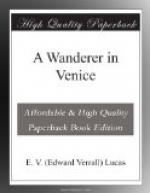The church of S. Rocco is opposite, and one must enter it for Tintoretto’s scenes in the life of the saint, and for a possible Giorgione over the altar to the right of the choir in a beautiful old frame. The subject is Christ carrying the cross, with a few urging Him on. The theory that Giorgione painted this picture is gaining ground, and we know that only about a century after Giorgione’s death Van Dyck, when sketching in Venice, made some notes of the work under the impression that it was the divine Castel Francan’s. The light is poor and the picture is in a bad state, but one is conscious of being in the presence of a work of very delicate beauty and a profound soft richness. The picture, Vasari says, once worked miracles, and years ago it brought in, in votive money, great sums. One grateful admirer has set up a version of it in marble, on the left wall of the choir. Standing before this Giorgione, as before the Tintorettos here and over the way, one again wishes, as so often in Venice, that some American millionaire, in love with this lovely city and in doubt as to how to apply his superfluity of cash, would offer to clean the pictures in the churches. What glorious hues would then come to light!
CHAPTER XXIII
THE FRARI AND TITIAN
A noble church—The tomb of Titian—A painter-prince—A lost garden—Pomp and colour—A ceaseless learner—Canova—Bellini’s altar-piece—The Pesaro Madonna—The Frari cat—Tombs vulgar and otherwise—Francesco Foscari—Niccolo Tron’s beard.
From S. Rocco to the Frari is but a step, and plenty of assistance in taking that step will be offered you by small boys.
Outside, the Frari—whose full title is Santa Maria Gloriosa dei Frari—is worth more attention than it wins. At the first glance it is a barn built of millions of bricks; but if you give it time it grows into a most beautiful Gothic church with lovely details, such as the corbelling under the eaves, the borders of the circular windows, and still more delightful borders of the long windows, and so forth; while its campanile is magnificent. In size alone the Frari is worthy of all respect, and its age is above five centuries. It shares with SS. Giovanni e Paolo the duty of providing Venice with a Westminster Abbey, for between them they preserve most of the illustrious dead.
Within, it is a gay light church with fine sombre choir stalls. Next to S. Stefano, it is the most cheerful church in Venice, and one should often be there. Nothing is easier than to frequent it, for it is close to the S. Toma steamboat station, and every visit will discover a new charm.




